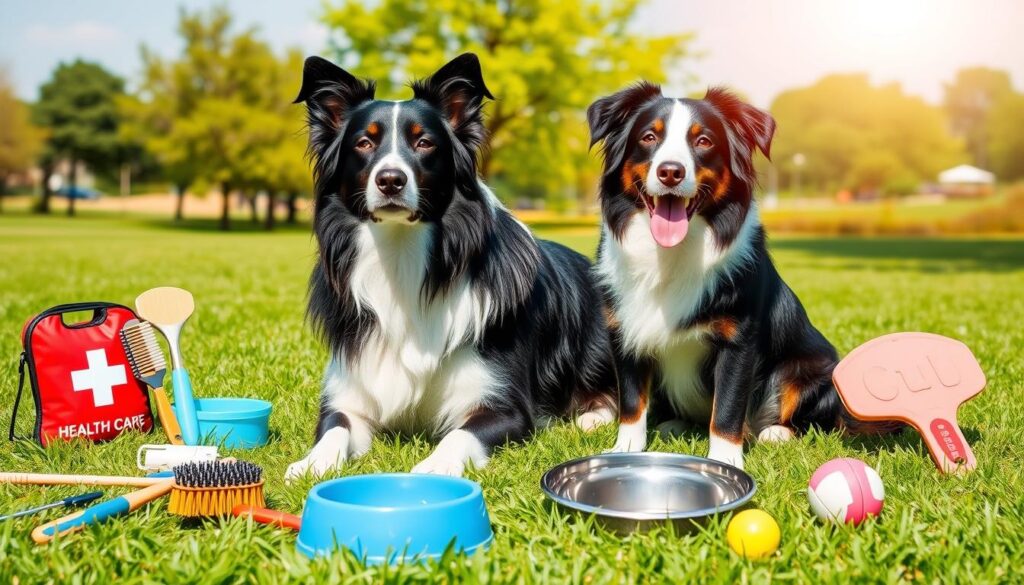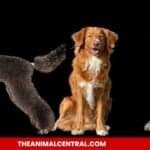Did you know Border Collies can learn new commands in fewer than 5 repetitions? This shows why they’re called the Einstein of dogs. I’m excited to share insights that will interest both seasoned owners and those thinking of getting one.
Originally bred for herding, Border Collies have become versatile companions. They’re not just smart; over 70% are used in herding today. They also excel in obedience and agility, making them one of the smartest dog breeds.
Having a Border Collie is rewarding but comes with big responsibilities. They need about 2 hours of exercise daily to stay healthy. Their intelligence and energy require an active lifestyle and dedicated training.
In this guide, we’ll cover everything about owning a Border Collie. We’ll look at their history, physical traits, exercise needs, and training. This guide is for both current owners and those thinking of adopting a Border Collie.
Key Takeaways
- Border Collies learn new commands in under 5 repetitions
- Over 70% are used for herding livestock
- They require about 2 hours of daily exercise
- Border Collies excel in obedience and agility competitions
- Proper socialization benefits approximately 80% of owners
- Their lifespan typically ranges from 12 to 15 years
- They need regular mental and physical stimulation to prevent boredom
Border Collie Breed Overview
| Breed Attributes | Details |
| Origin | Scottish-English border |
| History | Developed for herding sheep |
| Affectionate with Family | Very high |
| Good with Children | Yes, but may herd them |
| Good with Other Dogs | Generally good |
| Ideal Family | Active, outdoorsy families |
| Space Needs | Large space preferred |
| Shedding Level | Moderate to high |
| Coat Grooming Frequency | Weekly |
| Coat Type | Double coat, rough or smooth |
| Coat Length | Medium |
| Drooling Level | Low |
| Openness to Strangers | Reserved |
| Playfulness | Very high |
| Type of Dog | Herding, can be watchdog |
| Trainability | Highly trainable |
| Energy Level | Very high |
| Barking Level | Moderate |
| Mental Stimulation Needs | Very high |
| Dietary Requirements | High-quality diet for active dogs |
Understanding the Border Collie Breed History
The story of the Border Collie is truly captivating. This sheepdog breed has a long history, with its modern form emerging over 130 years ago.
Origins as a Herding Dog
Border Collies come from Northumberland, near the England-Scotland border. Their history goes back to Roman drover dogs from 2,000 years ago. Vikings also brought their herding dogs to England, helping shape the breed.
Development of Working Traits
Over time, Border Collies became known for their exceptional herding skills. The first sheepdog trial was held in Wales in 1873. The International Sheepdog Society, founded in 1906, helped refine these traits.
Evolution into Modern Companion Dogs
Border Collies have kept their herding instincts but also make great pets. The American Kennel Club recognized them in 1955. Today, they’re celebrated for their intelligence and versatility, excelling in dog sports and as family pets.
| Year | Event |
|---|---|
| 1557 | Earliest documented descriptions of shepherd dogs |
| 1873 | First formal sheepdog trial in Wales |
| 1906 | International Sheepdog Society formed |
| 1915 | Term “Border Collie” first used |
| 1955 | AKC recognition of Border Collie breed |
Physical Characteristics and Appearance
Border Collies are medium-sized dogs known for their athletic build and distinctive appearance. They are energetic companions with unique physical traits.
I’ve noticed that Border Collies usually stand 18 to 22 inches tall. They weigh between 30 to 55 pounds. They live for 12 to 15 years, which is a big commitment for owners.
One of the most striking features of a Border Collie is their coat. They come in various colors and patterns, including:
- Solid colors: Black, white, chocolate, blue, brown, red, liver
- Bi-color combinations: Black/white, red/white, blue/white
- Tri-color options: Black/white/brown, black/white/red
- Merle variations: Blue merle, red merle, chocolate merle
Their coat can be long, medium, or short, with textures ranging from smooth to rough. During shedding season, which occurs twice a year, daily brushing is essential to manage their coat.
| Characteristic | Description |
|---|---|
| Build | Athletic, medium-sized |
| Coat Types | Long, medium, short |
| Common Colors | Black, white, chocolate, blue |
| Exercise Needs | High (1+ hour daily) |
| Intelligence | Very high |
Border Collies are known for their intense, intelligent gaze and alert expression. These physical traits make them highly capable and energetic companions.
The Intelligence of Border Collies
Border collie intelligence is truly remarkable. These dogs are widely regarded as the smartest breed, consistently topping intelligence rankings. Their cognitive abilities go far beyond simple obedience, making them stand out as an intelligent breed.
Problem-Solving Abilities
Border Collies excel at solving complex problems. Their quick thinking and adaptability allow them to overcome challenges with ease. For example, Chaser, a famous Border Collie, learned the names of over 1,000 objects, showing the breed’s exceptional memory and language skills.
Learning Capacity and Training Response
The learning capacity of Border Collies is unmatched. They can pick up new commands rapidly, often anticipating instructions before they’re given. This quick response to training makes them ideal for various dog sports and working roles. In fact, Border Collies dominate competitions in agility, flyball, and herding trials.
Mental Stimulation Requirements
To keep a Border Collie happy and well-behaved, mental stimulation is key. Without enough intellectual engagement, these dogs may develop undesirable behaviors. Puzzle toys, training sessions, and interactive games are essential for satisfying their cognitive needs. Regular mental exercises help prevent boredom and maintain their overall well-being.
| Trait | Description |
|---|---|
| Intelligence Ranking | #1 in working intelligence |
| Learning Speed | Extremely fast |
| Problem-Solving | Exceptional ability |
| Mental Stimulation Needs | High |
Exercise and Activity Requirements
Border Collies are full of energy and need lots of exercise. This keeps them both physically and mentally healthy. As their owner, it’s key to meet their activity needs for a good relationship.
Daily Exercise Needs
Healthy adult Border Collies need at least 90 minutes of exercise daily. This is vital for their active lifestyle. For puppies, the rule is five minutes per month of age. As they grow, they need more exercise.
Recommended Activities
I keep my Border Collie busy with various activities. We go on long walks, run, swim, and do agility training. These activities meet their physical and mental needs, which is important for their intelligence.
Energy Management Strategies
Managing a Border Collie’s energy is a challenge. I split their exercise into smaller sessions throughout the day. Using interactive toys and puzzles helps them use their energy wisely. Remember, exercise needs change with age, health, and personality.
| Age Group | Exercise Duration | Activity Type |
|---|---|---|
| Puppy (3 months) | 15 minutes | Gentle walks, short play sessions |
| Adult (1-7 years) | 90-120 minutes | Intense activities, agility, long walks |
| Senior (8+ years) | 60-90 minutes | Moderate walks, swimming, low-impact exercises |
By understanding and meeting these exercise needs, I keep my Border Collie happy and balanced.
Training Your Border Collie
Training a Border Collie is a thrilling adventure. It unlocks their incredible intelligence and desire to please. These dogs learn fast, often beating other breeds in obedience training. Their high energy and sharp minds need a special training approach.
Positive reinforcement is essential for Border Collies. I reward them with treats, praise, and playtime for good behavior. Clicker training is also great, using a click sound with treats to mark good actions. This method is perfect for a breed that doesn’t take well to harsh corrections.
Early socialization is vital for Border Collies. I introduce them to different people, animals, and places to prevent shyness or aggression. This helps control their natural herding instincts, which can cause chasing if not directed right.
Mental challenges are as important as physical exercise for Border Collies. I add puzzle toys and complex tasks to their daily routine. Without these, their intelligence can lead to boredom and bad behavior.
| Training Aspect | Recommendation |
|---|---|
| Exercise Requirement | Over 2 hours daily |
| Training Frequency | Continuous |
| Recall Training | Essential due to herding instincts |
| Socialization | Critical for positive interactions |
Consistency is the key in training a Border Collie. They love routine and clear rules. With patience and commitment, you’ll have a well-behaved, joyful companion ready for any challenge.
Health Care and Maintenance

Border collies are known for their strong health. But, they need the right care. I’ll show you how to handle common health issues, prevent them, and schedule vet visits to keep your dog healthy.
Common Health Issues
Border collies can face several health challenges. Hip dysplasia is a big concern for their hip joints. Collie Eye Anomaly can affect their vision by 5-6 weeks.
Epilepsy often starts between 2-5 years and needs careful management. Trapped Neutrophil Syndrome (TNS) can be deadly if not treated quickly.
Preventive Care Measures
Regular exercise is key. Young border collies need 1-2 hours a day, while older ones need about 30 minutes. Feeding them right is also important – adult dogs should eat twice a day, and puppies three times.
Vaccinations are a must, as young dogs are more at risk. Keeping them free from fleas, ticks, and worms is also critical for their health.
Veterinary Check-up Schedule
I suggest a detailed check-up schedule for your border collie:
| Age | Check-up Frequency | Focus Areas |
|---|---|---|
| Puppy (0-1 year) | Every 3-4 weeks | Vaccinations, deworming, growth monitoring |
| Adult (1-7 years) | Annually | General health, dental check, parasite control |
| Senior (7+ years) | Bi-annually | Arthritis screening, cognitive health, organ function tests |
Remember, a healthy border collie is a happy one. With the right care and regular vet visits, your dog can live a long and happy life of 12-15 years.
Grooming and Coat Care
Border collies, known as energetic companions, need regular grooming. This keeps their double coats in great shape. Proper care boosts their looks and health.
Brushing Techniques
For border collies, brush them three times a week. This helps manage shedding and prevent matting. In spring and autumn, brush them every 14 days to handle heavy shedding.
- Use an undercoat rake to remove loose hair
- Follow with a pin brush to remove dirt and dust
- Finish with a slicker brush for a smooth coat
Bathing Schedule
Bathe your border collie once a month, or as needed. Avoid overwashing to keep natural oils. Use conditioner after bathing to ease shedding and keep the coat healthy.
Seasonal Grooming Needs
In shedding seasons, I groom more. Professional grooming every 8 to 12 weeks helps manage heavy shedding. I also moisturize paw pads and nose to prevent cracking.
| Grooming Tool | Price | Purpose |
|---|---|---|
| Undercoat Rake | £5.79 | Remove loose undercoat |
| Medium Pin Brush | £5.79 | Remove dirt and dust |
| Matt Breaker | £6.63 | Remove mats and tangles |
| Performance Shine Shampoo | £24.96 | Clean without drying |
Regular grooming not only keeps your border collie looking great. It also strengthens your bond with this energetic companion. Don’t forget to brush their teeth and clean their ears for complete care.
Nutrition and Feeding Guidelines

Feeding a border collie right is key for their active life. They need a diet full of protein to keep up with their busy days. For a border collie that exercises 2 hours a day, 20% protein is perfect. If they’re into agility, up it to 22% for extra energy.
How often you feed them is also important. Adult border collies should eat twice a day, adjusting the amount based on how active they are. Make sure to feed them before exercise to prevent stomach problems.
While dried dog food is easy, adding fresh meats and veggies is a great idea. It’s what Border Collie Rescue does, and it keeps them healthy and balanced.
| Dog’s Activity Level | Recommended Protein % |
|---|---|
| Limited Exercise | 18% |
| Average Exercise (2 hours/day) | 20% |
| High Activity (Agility, Jogging) | 22% |
| Ill or Pregnant | Up to 24% |
Every border collie is different. Talk to your vet to create a diet plan that fits your dog’s needs. This way, they’ll always be ready for their next adventure.
Living Environment and Space Requirements
Border collies love open spaces, making them great for active families. They need lots of room to play and run around. Even though they can live in different homes, they’re happiest with plenty of space to play.
Indoor Living Considerations
Keeping a border collie indoors means creating a calm space. They do best in quiet areas to avoid getting too excited. I set up special sleeping spots for them, one for night and another for naps.
Outdoor Space Needs
A safe, fenced yard is perfect for border collies. It lets them run and play freely. My border collie loves exploring the backyard, sniffing around and finding new smells.
This outdoor time keeps them happy and mentally sharp.
Creating an Enriching Environment
To keep my border collie busy, I focus on fun activities, not just exercise. I do daily training, scent games, and different playtime. This keeps their working dog spirit alive and prevents boredom.
By giving them a daily task or ‘mission’, they feel fulfilled and happy at home.
Socialization and Family Integration
Border collies are great with families if they’re socialized early. They become loving and playful members of the family. These smart dogs bond well with kids.
It’s important to introduce your border collie to many people, animals, and places when they’re young. This helps avoid bad behaviors later. Early socialization makes them better behaved and keeps the family happy.
Teaching kids and your border collie together strengthens family ties. It also helps keep the dog well-trained. Everyone in the family gets to help with the dog’s care and learning.
About 30% of border collies might herd people or animals if they’re not trained. They need lots of exercise and brain games to stay happy and healthy.
| Aspect | Impact on Family Integration |
|---|---|
| Early Socialization | Reduces behavioral issues, improves adaptability |
| Family Involvement | Enhances bonding, ensures consistent training |
| Regular Exercise | Prevents boredom, reduces problem behaviors |
| Proper Training | Mitigates herding tendencies, improves obedience |
By focusing on these key points, you can make your border collie a loving part of your family. This creates a happy and fulfilling home for everyone.
Conclusion
I’ve looked into Border Collies, a smart breed that makes great energetic friends. They are known for solving problems well. Studies show they can learn and remember toy names with 86% accuracy.
They also understand colors and complex commands. This makes them perfect for jobs like therapy and service work.
Border Collies need lots of mental and physical activity. They should get at least 1-2 hours of exercise every day. They do well in dog sports like agility.
Their short-haired coats are 18-22 inches tall and weigh 30-45 pounds. They live for 12-15 years on average. Keeping their coats clean with weekly grooming is important.
Regular vet visits help prevent health problems like hip dysplasia.
Having a Border Collie is a rewarding experience. But, it requires a lot of time and effort. If you’re up for an active life and a deep bond, a Border Collie might be right for you.
Remember, these dogs are more than pets. They are smart partners ready to learn, work, and love.
FAQ
How intelligent are Border Collies compared to other dog breeds?
How much exercise does a Border Collie need daily?
Are Border Collies good family dogs?
How often should I groom my Border Collie?
Can Border Collies live in apartments?
What health issues are common in Border Collies?
How trainable are Border Collies?
Do Border Collies shed a lot?
Are Border Collies good with other pets?
How long do Border Collies typically live?
References
| American Kennel Club (AKC) | https://www.akc.org/dog-breeds/ |
| United Kennel Club (UKC) | https://www.ukcdogs.com/ |
| Canadian Kennel Club (CKC) | https://www.ckc.ca/en |
| Fédération Cynologique Internationale (FCI) | https://www.fci.be/ |







